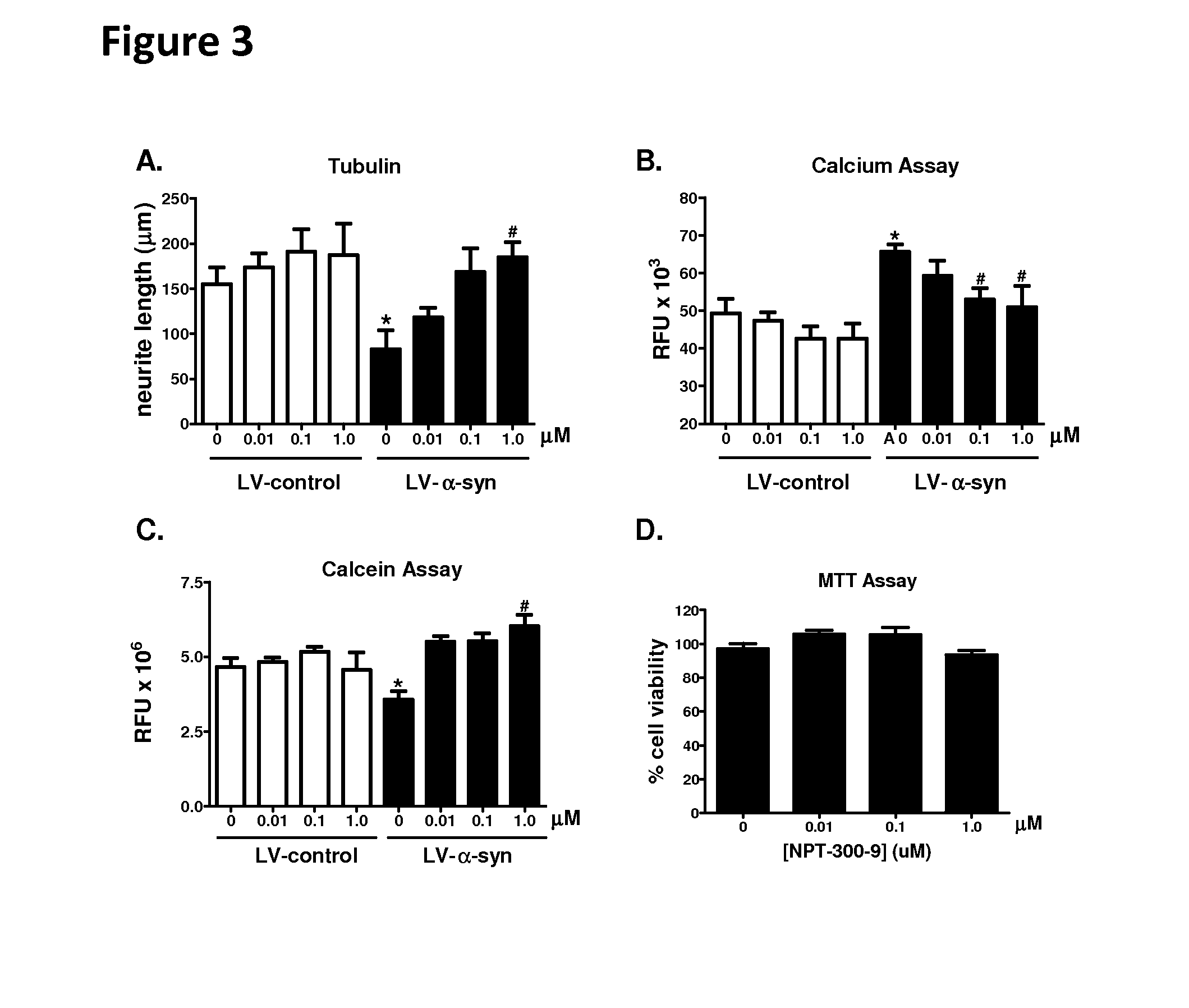Phenyl-urea and phenyl-carbamate derivatives as inhibitors of protein aggregation
- Summary
- Abstract
- Description
- Claims
- Application Information
AI Technical Summary
Benefits of technology
Problems solved by technology
Method used
Image
Examples
example 1
3-((1H-Indol-3-yl)methoxy)-5-butylphenyl(2-(4-methylpiperazin-1-yl)ethyl)carbamate
[0124]
[0125]Step 1. To a solution of 1H-indole-3-carbaldehyde (29.2 g, 0.2 mol), 4-(dimethylamino)pyridine (1.28 g, 0.01 mol), and triethylamine (30.3 g, 0.3 mol) in dichloromethane (100 mL) was added dropwise di-tert-butyl dicarbonate (Boc2O) (65.2 g, 0.2 mol) at 0° C. The mixture was stirred at room temperature overnight. Dichloromethane (100 mL) was added and the organic layer was washed with H2O (3×50 mL) and brine (50 mL) and dried over anhydrous sodium sulfate. After filtration, the filtrate was concentrated to give tert-butyl 3-formyl-1H-indole-1-carboxylate (44 g, 90%). 1H NMR (400 MHz, CDCl3) δ: 1.71 (s, 9H), 7.44-7.25 (m, 2H), 8.15 (d, 1H), 8.24 (s, 1H), 8.29 (d, 1H), 10.1 (s, 1H).
[0126]Step 2. To a solution of tert-butyl 3-formyl-1H-indole-1-carboxylate (44 g, 0.17 mol) in ethanol (50 mL) was added sodium borohydride (16.6 g, 0.45 mol) at 0° C. The mixture was stirred at room temperature for...
example 2
1-(4-((1H-Indol-3-yl)methyl)-3-butyl-5-hydroxyphenyl)-3-(2-(4-methylpiperazin-1-yl)ethyl)urea
[0136]
[0137]Step 1. n-BuLi (520 mL, 1.274 mol, 2.5 M solution in hexane) was added dropwise to 700 mL of dry methanol with vigorous stirring at −78° C. under N2. The mixture was stirred for 30 min at room temperature after addition was complete. The solvent was removed under reduced pressure and the residue was dissolved in 1 L of hexamethylphosphoramide and cooled with an ice bath. 3,5-Dinitrobenzoic acid (100 g, 0.472 mol) was added to the stirring solution. The mixture was stirred for 5 h at room temperature and then stirred for 12 h at 80° C. The reaction mixture was cooled to room temperature and diluted with 2 L of H2O, acidified with 600 mL of aqueous H2SO4 (6 M), and extracted with methyl tert-butyl ether (3 L). The organic phase was washed with brine, dried over Na2SO4, and concentrated to give 3-methoxy-5-nitrobenzoic acid (600 g, 81%, 8 batches). 1H NMR (400 MHz, DMSO) δ 3.91 (s, ...
example 3
1-(4-((1H-indol-3-yl)methyl)-3-ethylphenyl)-3-(2-(4-methylpiperazin-1-yl)ethyl)urea
[0145]
[0146]Step 1. To a solution 2-bromo-4-nitrobenzoic acid (100.0 g, 0.4 mol) and 1,8-diazabicyclo[5.4.0]undec-7-ene (80 g, 0.6 mmol) in acetonitrile (500 mL) was added MeI (120 g, 0.8 mol) dropwise at 0° C. The resulting mixture was stirred at 25° C. for 12 h. The mixture was concentrated and diluted with 300 mL CH2Cl2, washed with 2 N HCl (3×100 mL), 2 N NaOH (2×100 mL), and brine, dried over anhydrous Na2SO4, and concentrated to give methyl 2-bromo-nitrobenzoate (104 g, 100%) as a white solid. 1H NMR (400 MHz, CDCl3) δ: 4.01 (s, 3H), 7.93-7.95 (d, J=8.8 Hz, 1H), 8.22-8.24 (m, 1H), 8.53-8.54 (m, 1H).
[0147]Step 2. A mixture of methyl 2-bromo-nitrobenzoate (22.0 g, 84.6 mmol), vinylboronic anhydride pyridine complex (20.2 g, 84.1 mmol), Pd(PPh3)4 (4.9 g, 4.33 mmol), and K2CO3 (46.5 g, 336.8 mmol) in toluene / ethanol (1:1, 820 mL) was stirred at 90° C. under N2 for 2 h. The reaction mixture was conce...
PUM
| Property | Measurement | Unit |
|---|---|---|
| Pharmaceutically acceptable | aaaaa | aaaaa |
Abstract
Description
Claims
Application Information
 Login to View More
Login to View More - R&D
- Intellectual Property
- Life Sciences
- Materials
- Tech Scout
- Unparalleled Data Quality
- Higher Quality Content
- 60% Fewer Hallucinations
Browse by: Latest US Patents, China's latest patents, Technical Efficacy Thesaurus, Application Domain, Technology Topic, Popular Technical Reports.
© 2025 PatSnap. All rights reserved.Legal|Privacy policy|Modern Slavery Act Transparency Statement|Sitemap|About US| Contact US: help@patsnap.com



